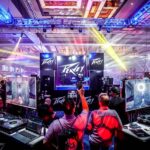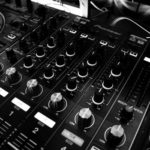Ok – so you’ve made the leap of faith to start researching what it takes to become a DJ.
A quick search of “DJ Equipment” on google can be very intimidating with all the different brands, pricing, and function… But don’t fret! We’re here to break it down for you! Grab a drink and some popcorn because we’re about to go on a informational journey together.
First things first, a breakdown of terminology:
- Deck (a.k.a. playback method) – what you will be using to play/control a song
- Mixer – what’s used to connect your decks together and mix them
- DJ Program – this is a program that will connect your decks to your computer to play the music you’ve downloaded
- Pitch Control – How fast or slow the deck will controls a song
- Audio Interface – The box that connects your computer to your decks/mixer to play music that you’ve downloaded digitally
A basic DJ setup will involve 3 things:
- 2 Decks
- 1 Mixer
- An audio interface to connect to your laptop to the DJ program
(an audio interface may be forgo if your mixer has a the audio interface built-in to the mixer)

Alright, so… what deck should you get?
There are 2 main types of decks used in the industry now-a-days: TURNTABLES and CDJS
TURNTABLES

Turntables have been around since the 1800s – peaking it’s popularity in the 1980/1990s, these record players were created to play 12” records. This technology is as simple as it gets, a platter spins a record and a needle plays the grooves in the record, making sound.
The pure simplicity of this playback method is what attracts alot of DJs to pick turntables as their main choice of deck, you know exactly if your track is playing and how fast it’s playing by just looking at the platter spinning in front of you.
Pros:
- Maximum control and visual representation of what your deck is doing
- Well respected in the DJ community
Cons:
- Heavy
- Need maintenance and upkeep
- Pitch control is not precise
- Needle gets affected by heavy bass or dirt
What DJs normally use turntables:
- Hip Hop DJs
- Scratch DJs (turntablist)
Additional equipment needed with turntables:
- Needles
- Records
Pricing:
- 300-1000$ per
Models of turntables that are commonly used:
- Technic 1200 (MK2, MK3, M3D, MK4, MK5, MK6) See the differences in models here
- Pioneer PLX Series (PLX-500, PLX-100)
- Reloop RP Series (RP-4000, RP-8000)
- Stanton STR8
Notable DJs that use Turntables:
- DJ ATRAK
- DJ SNAKE
- DJ JAZZY JEFF
CDJS
CDJs came into the DJ scene in 1994 with the Pioneer CDJ-500. The CDJ originally only played CDs (hence the name) but now, a CDJ can play a USB stick, SD card, a laptop, and of course a CD. Watch a brief history of the CDJ here.
CDJs offer precise pitch control, reliability, and ease of use. The CDJ is slowly becoming the DJ industry standard.
Pros:
- Precise pitch control
- Display screen to provide BPM, Song, and Waveform information
- Several different options for media to be inserted
- Does not get affected by heavy bass
Cons:
- Expensive
- Platter doesn’t have the same feedback as a turntable
What DJs normally use turntables:
- EDM DJs
- Hip Hop DJs
Additional equipment needed with CDJs:
- CD/USB stick/SD card
Pricing:
- ~700-2000$ per
Models of CDJs that are commonly used:
- Pioneer CDJ-2000
- Pioneer CDJ-900
- Pioneer CDJ-1000
Notable DJs that use CDJs:
- SKRILLEX
- STEVE AOKI
- LAIDBACK LUKE
Now for your audio interface
Your audio interface/program will connect to your decks, your computer, and your mixer. This device will let you play the songs on your laptop into your mixer. This is a tough choice because most likely, the audio interface/program you start off will be the audio interface/program you’ll end up using for the rest of your career.
The main 2 audio interfaces in the market right now:
- Serato
- Traktor
Serato – Serato is the most prevalent and most used DJ interface/software used in the industry today. 90% of DJs you’ll see at gigs will be using Serato.
What to buy: an SL1, SL2, SL3, or SL4 box (Note: SL1 and SL2 will not work with the latest Serato DJ Program)
Price range: 120-800$
Traktor – Traktor is a second runner up in the race of audio interfaces/programs. Traktor is more popular in the controller format (we will talk about this later)
What to buy: Traktor Audio 6
Price: 200$
We often times analogize Serato vs. Traktor much like iPhone vs. Android. Serato is a very simple program, is intuitive to use, and does not have much customizability whereas Traktor has tons of customizability but not as simple to use as Serato.
PHEW. Now for a mixer
Remember – the main purpose of a mixer is to plug your decks into and mix the sounds coming from your two decks together and output them to the speaker(s).
There’s tons of mixers on the market and to save you from the information overload we’re going to keep it simple in this section.
You can choose a mixer WITH an audio interface built inside or a mixer WITHOUT a audio interface built inside. Of course, if you choose one without a audio interface built inside you’ll have to buy one (refer to section above).
To keep it simple, we’re just going to give you two great mixers from each category:
Mixers with audio interfaces
Pioneer S9

This mixer has Serato built in and is a 2-channel mixer (that means it can play two audio inputs simultaneously). The DJ world went crazy when the S9 released in 2015 with on board cue buttons, dedicated channel effects and extreme fader customizability.
Price: 1500$
Pioneer DJM-900 SRT

The Pioneer DJM-900 SRT is a 4 channel mixer (which means you can mix 4 audio inputs at the same time) is a industry standard, the DJM series mixers have been a standard in clubs, festivals, and any production since the the 1990s.
Price: 2000$
Mixers without audio interfaces
Rane 56

The Rane 56 is a great mixer released in 2011 that was notoriously known for it’s smooth and sharp cutting faders. And it’s still a great mixer to this day!
Price: 400$
Pioneer DJ-400

The Pioneer DJM-400 is the 2 channel version of Pioneers Flagship DJM-800 and is a great mixer with on-board effects. This is a great budget mixer for any skill level.
Price: 300$
OK so like DJ Enzyme, we’ve broke down (HA-HA) the equipment that is needed to DJ. I know exactly what you’re thinking… Wow, that is some expensive s(*&#(*&
But wait… we’ve kept the best (for beginners) for last: Controllers.
CONTROLLERS
What’s a controller? Well basically a controller is 2 decks, a mixer, and an audio interface ALL IN ONE.

The DJ controller was introduced around 2007 but did not catch popularity until 2010 when Traktor released the Traktor S4, now consumers are starting to buy controllers instead of the conventional 2 decks and a mixer. Within the past few years, dozens on dozens of controllers have hit the market. Here’s some controllers we recommend:
Pioneer DDJ-SR

The DDJ-SR is Pioneers Mid-Tier 2-Channel DJ Controller that has the Serato audio interface built in, the bottom tier being the DDJ-SB and the top tier being the DDJ-SX. The DDJ-SR controller includes 8 cue button pads on each deck and dedicated filter knobs on each channel.
We don’t recommend the DDJ-SB as it requires you to use Serato Intro, a stripped down version of Serato DJ, which is missing a lot of functions. Secondly, in our opinion, theres not much of a performance difference to merit the price difference (500$) between the DDJ-SR and the DDJ-SX. For all intents and purposes, the DDJ-SR will perform just as well as the DDJ-SX. Therefore, this is our top recommendation for a DJ controller.
Price: 500$
Traktor S4

The controller that started it all, the Traktor S4 the big brother to the Traktor S2. This is (obviously) a Traktor based controller. The controller includes 4 channels, 4 cue button pads on each deck, and has dedicated filter knobs on each channel. This controller is widely used amongst big name artists like Zedd.
Price: 400$
OK – so you’re saying… these controllers are 10x cheaper than their counter parts, but industry professionals still use CDJs, Turntables, and Mixers? Why?
Controllers are GREAT! They are creating a whole new market for affordable DJing and the technology in them are exponentially increasing. Did I mention a hell of a lot lighter and smaller? Although the case, there are a few cons in comparison to the traditional CDJ/Turntable + Mixer route:
- The Platters are small, therefore decreasing your control over the platter
- Upgradability – Sometimes you just want to upgrade a deck or a mixer. In the case of a controller, that isn’t possible
- Amplified output – Since most controllers are powered via USB or a low DC voltage, the output of the mixer is generally very low and needs to be amplified greatly by the speaker
- If any part of your controller malfunctions or in the case someone spills liquid on it.. your whole setup is pretty much toast

*Arthur fist to those who spill drinks on DJ equipment*
Don’t get me wrong – these cons definitely do not outweigh the pros of a controller! We recommend a controller for all beginner DJs. Beacuse everything is integrated into one system, you can simply plug it into your laptop and dive into mixing at the fraction of the cost. As you grow and advance your skills with a controller you will start to notice its limitations. At this point you may consider an upgrade to a 2 deck + mixer system!








0 Replies to “Choosing DJ Equipment”